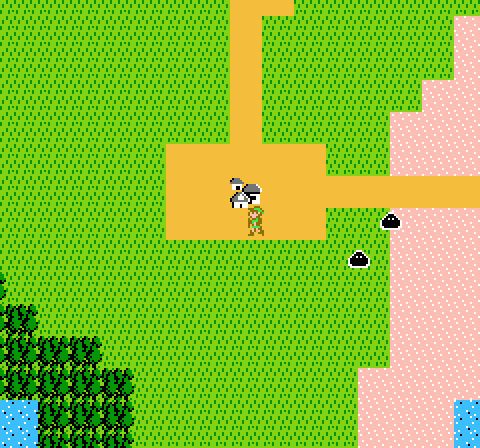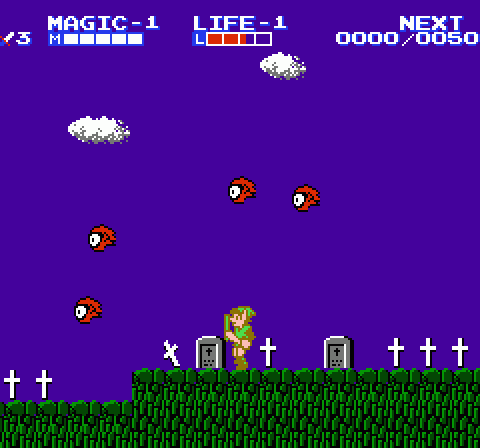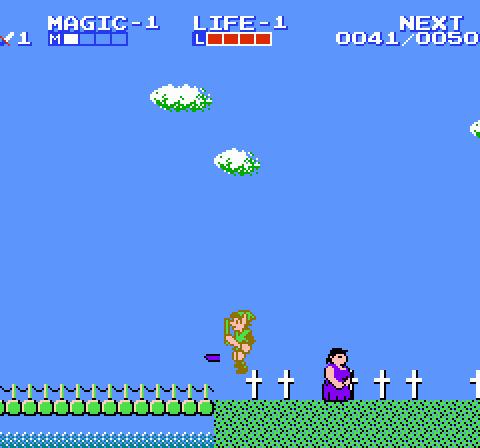We explored Zelda II‘s RPG lineage, but the game properly falls under the category of “action RPG.” Unlike just about other title I can think of that people cram under that term, though, Zelda II really and truly deserves the name. Its structure is straight-up classic RPG, full of fetch quests for NPCs, dungeons to conquer, towns to visit, and a separate world view for the act of travel and exploration.
Nintendo was kind enough to more or less do away with the idea of random battles, giving you a heads-up before an ambush with wandering enemy sprites that would pop up to allow you to try to avoid them or, failing that, at least allow you to brace yourself for the kind of enemy you were about to face. For “dungeons” — caves and palaces in this case — the random encounter metaphor disappears entirely to focus on pure action, albeit in a nonlinear setting; this does a remarkable job of creating the same sense of atmosphere as the first game’s underworld areas.

Above ground, enemy encounters vary based on the rank of foe icons that appear, the terrain type on which they meet Link, and the region of the world. Essentially, you can have one of two fixed encounter types per terrain tile depending on which section of the world you’re in (as in Dragon Quest, foes rank up when you cross a proverbial bridge). This is almost exactly the way the Final Fantasy games — the first of which launched in Japan 10 months after Zelda II — would handle its encounters. Enemies appear in set formations, exactly as they do here.
What makes Zelda II an action RPG, of course, is the way its battles unfold not as menu-driven turn-based affairs but rather as side-scrolling arcade combat sequences. Link’s skill set seems drawn from Namco’s 1984 arcade title Dragon Buster, with very little platforming despite the jumping; for the most part, fighting revolves around swordplay and maintaining a safe distance from foes while try to edge close enough to them to inflict damage on them.
Combat in Zelda II is often dinged for being sloppy or unpolished, which I don’t think is true. It carries over some core mechanics from the original game, most notably the use of sword and shield. Link’s shield isn’t just for show, and it deflects many enemy attacks, both projectiles and melee strikes. As such, he fights oh so slightly like Simon Belmont in the first two Castlevania games (and again, in a curious bit of parallel evolution, Simon’s Quest would give Simon a shield that works much like Link’s): You can attack either high or low, and your shield follows the level of your sword, allowing you to block at two levels, as well.

This proves to be essential in facing off again many humanoid foes: Moblins and Ironknuckles in particular use two-level melee strikes similar to Link, and defeating them requires quick reflexes as you watch their actions to see how they telegraph their attacks. The Ironknuckles’ shields block Link’s attacks just as his block theirs, and they sometimes seem psychic, so they can be tough to defeat. But they do give Zelda II the unusual distinction of including enemies that can go toe-to-toe with the hero on even terms rather than being mere fodder or overwhelmingly huge and powerful.
Link wields magic, but it acts almost entirely as a supplemental skill. The game contains only two offensive spells, neither of which you acquire until the game’s second half; the remainder buff him, heal him, improve his mobility and range, or provide passive defense. The bulk of his combat involvement revolves around swordplay. Zelda II offers a big improvement over its arcade predecessors by being very precise in its combat and making Link very limber and agile. He moves quickly and (especially with the Jump spell) can leap quite effectively. Later, he learns advanced sword techniques that give him the ability to attack foes above and below him (and the button combinations for these skills are refreshingly low on fussiness: Merely press up or down as you jump to stab in that direction).

This isn’t to say the combat doesn’t have its shortcomings. Link’s sword range is bafflingly short, so you have to get very close to enemies to attack them; as such, combat feels quite different from that of Castlevania despite some fundamental similarities — the Belmont way is the attack from a distance, given that family’s relative sluggishness. Link does carry over his sword beam from the original game, but as in the original Zelda it’s useless against many of the more powerful foes and vanishes the instant he takes a hit… even if the damage is so slight it doesn’t even register on life meter.
Foes never drop health. They only drop experience bags and magic refills. As a kid, I didn’t realize this meant you should use magic generously in combat, but yes: This is absolutely the case. The game becomes far less daunting when you make liberal use of the Shield spell, which can be refilled with a blue magic refill drop (and one drops in nearly every area).
Link lacks subweapons. The boomerang, the bomb, the arrow: None of those appear in Zelda II. This was clearly a deliberate decision by Nintendo to keep combat as simple as possible in light of the NES controller’s limitations. Still, it feels like something of a missed opportunity and limits combat. What if the boomerang worked like the missiles in Gradius, flying at foes as a supplemental attack when Link swings his sword? But alas, no.
And, finally, some of the enemy encounters you face simply aren’t fair. Many of the random fights in particular are clogged with constantly spawning foes that move quickly, offer little to no experience, and often drain experience points. These foes can be incredibly annoying and seem downright cheap, encouraging players to avoid random battles rather than play through them for fun. Even in fixed encounter areas, such as palaces, some of the smaller infinitely spawning enemies can be a real irritant. The third palace in particular features disembodied dog heads that fly slowly in a square wave pattern and fire projectiles at the apex or nadir of their patterns and appear up to four at a time. They spawn ahead of Link, but should the player turn the other direction while facing them, Link will suddenly be flanked and will likely end up stunlocked by projectiles firing constantly from both directions. While the game is solidly designed more often than not, situations like that can be downright enraging.
Still, even with its flaws, Zelda II works remarkably well as a very literal and very faithful exploration of the action RPG. As we’ve seen very recently with Luigi’s Mansion: Dark Moon and Pikmin, Nintendo excels at sneaking action elements into otherwise staid genres like adventure games and real-time strategy. And here is where that tradition began.
I just started in on this (currently farming some exp at the Swamp Palace, gotta love a free regenerating red magic bottle), and the potential for stun-locking is definitely one of the more irritating parts of the combat system. It’s not hard to find yourself in situations where it’s impossible to block everything coming at you, on different heights or from different directions. The only recourse is not to let it happen in the first place, but that’s frequently easier said than done.
Although it goes both ways to some extent, as many of the weaker enemies can be rendered completely harmless by stun-locking them right back - once you get in range, anyway. And of course it doesn’t work on most sturdier, bipedal foes.
The trick for some of the swarming enemies (like those gargoyle heads) tends to be use of the jump spell (usually combined with downthrust). Of course, this can also leave you open to getting knocked into lava or something if you aren’t careful, but that’s always been the best way to deal with them I’ve found.
Zelda II’s sword beam is actually significantly nerfed compared to the original. Both only work at full hearts, but Zelda 1’s functionally has the same firing range and rate as the bow and rod, hits with the same strength as the actual sword firing it, and can hit everything the sword can hit. In comparison, Zelda II’s only travels about 12 feet from Link before disappearing and can’t even hurt most enemies.
Since most of the tools Link gets are used as funny-shaped keys for funny-shaped locks, the closest thing Link has to traditional tools are his temporary effect spells, most of which would’ve been standard tools in any other Zelda or Metroidvania game and which I’ll put possible analogues for in parentheses. You have a shield spell (tunic upgrade), a jumping spell (new boots), a healing spell (medicine/potion), a reflecting spell (shield upgrade), and a fireball shooting spell (rod). The Spell spell and Thunder spell would most likely still be magic consuming things, and the fairy could probably work as one of those gimmick tools you only use for one dungeon.
Definitely agree with MetManMas on the sword. The one in the first Zelda is far more useful, and sadly, A Link to the Past seems like it borrowed more from Zelda II, or perhaps met halfway. Skyward Sword’s was fairly potent, as I recall, but had the charge time to deal with. At least you could store it.
Incidentally, I don’t remember every having any stunlock problems in the game.
The assessment of how combat can seem unfun is pretty accurate, though. Before I became better at the game and basically “took on all comers,” I’d avoid combat as well.
Losing experience points more often than you can gain them is especially bad and weird. Given they mark “experience,” it’s difficult to imagine them being taken away. I think I’ve said this before, but Link gets knocked on the head a bit too hard, perhaps?
Also: I love the Gradius-styled Boomerang idea.
This game needs a remake. So does Metroid 2. Nintendo why don’t you want our money?
Yeah Metmanmas is right on the money regarding combat. I do wish Link’s sword slash had a little more reach (also I wish his knock-back wasn’t quite so far when getting hit), but otherwise I love the combat.
ReyVGM: Agreed. So very much so.
Might as well remake the original Legend of Zelda, too.